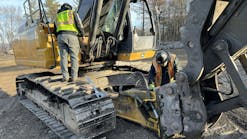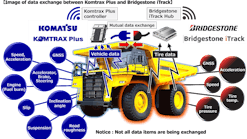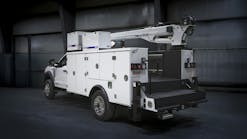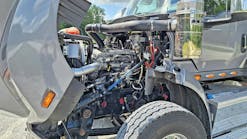It’s a philosophy that has stayed with him as he’s progressed from lube technician to equipment superintendent—even though Orcutt jokes the tenet now has become “[The supply of] oil is getting tough and not cheap—and parts aren’t any cheaper.”
The point is that paying attention to oil and lube quality pays off by preventing costly component failure, as well as savings on fluid resampling and associated labor.
Orcutt is member of the Under 40 in Construction Equipment Class of 2021.
“It’s a lot easier to change oil and wear parts than it is hard components and bearings,” Orcutt says. “Although it’s not as gratifying as a technician, it’s much cheaper for the company in the long run.”
Orcutt, who helps manage about 500 pieces of grading equipment and 300 to 500 on-road vehicles, has been at the forefront in establishing Sherwood’s latest oil- management program. His biggest motivation was the company’s bottom line.
“At the end of the day, it’s to reduce that operating cost,” explains Orcutt. “I’ve noticed over time that the shop is often viewed as an expense center, whereas we really can be that added value, that cost savings, or that risk management—however you want to view the portfolio we can bring. This is especially true with a well-educated equipment manager. There’s a lot of cost savings that can be had.”
How to prove the value of oil management
“On oil management, it’s still a lot of voodoo to a lot of people,” Orcutt says. “You can’t see those particles, so do they really exist, or is it just another way to spend more money?”
“An oil program has to play into your whole business model and sometimes it’s more easily sold than other times, but it’s hard to go into the C-suite and tell them we need to spend $250,000 on oil management,” Orcutt says.
It’s easier with equipment, Orcutt points out. With an excavator, income is more easily demonstrated through moving a fixed amount of dirt per hour, knowing the life on the machine and calculating the return on that, and similar, hard data.
Orcutt, and his mentor, corporate equipment manager Doug King, CEM, started by watching a number of oil analysis reports and noticing that the ISO reporting codes were exceptionally high, particularly on hydraulic oil.
“The six- and 14-micron-sized particles seemed to be above the thresholds that our OEMs were recommending for machines,” Orcutt says. “So doing more and more research, and leaning on a partner, WearCheck USA, and AEMP, we started asking questions at conferences and meetings. We wanted to know what it meant, and how do we get these levels? And what are the consequences if we do or don’t?”
Eventually, Orcutt and King were able to present to management the effects of too many particles and the subsequent reduction of component life, as well as show what operating costs and component lives would look like with and without oil management. An ROI forecast was born.
There was also more evidence of specific failures.
“We were seeing a lot of premature cylinder failures, some transmission clutch pack failures, engine failures, and valve train failures within engines that we thought were early for the lifecycle of the machine,” Orcutt says.
Although part of the problems were emissions related, which wasn’t accounted for in the early days of the program, there were also issues with legacy non-emissions machines.
“We were seeing engine failures at the 7,000- to 9,000-hour range on machines we were expecting to go out 10,000 to 12,000 hours,” Orcutt says. “That was the precursor for really diving into this.”
In the days before establishing the new program, the company was seeing some failures in machines in which fluids had just been changed. “We were really looking for large failures, but other than that, we were pretty reactive,” Orcutt says. “As in ‘Uh oh, the D9 just blew up, time to act.’ Or, we were inventorying engines on our scraper fleet. We used to keep a spare engine all ready, and your inventory cost there is $120,000 or $130,000 for a 3408 engine. By the time you put a rebuild in it, buy a block, and everything else, there’s pretty expensive costs there just [to be managing] for ‘Uh oh, something went bad.’”
Now, Orcutt can better forecast preventive maintenance, and suppliers can carry such inventory.
The cornerstone of the program is using a third-party company for analysis. For Sherwood, that’s WearCheck USA, in Cary, North Carolina. The beauty of using a third party lies in its independence, Orcutt says.
“The real logic of going to a third-party lab was that not only does it give some accountability to us as a customer, but also to our oil lab and our dealership, since there was no one that really had anything to gain by the test results or the diagnostic advice given with the results,” Orcutt says.
“The lab is impartial; they just want to give us the results,” he continues. “This gives us a leg up going in to talk to everyone because when we first started, it was ‘It’s your oil causing the engine failure,’ or ‘Your engine sucks and it’s not the oil.’”
Further, the lab provides Sherwood with a web-based platform that allows it to see all its samples together for easy management. “This beats getting a paper or email for each machine and the problem of how you document what you did to it and what the next step is,” Orcutt says. “It’s especially important when you’re managing a fleet across three or four states as Sherwood does. There’s a web-based portal so everyone can see the entire history instead of it all being in someone’s head.”
Sherwood now manages any sample point on its grading equipment, specifically for what Orcutt calls his “big three” oils: engine, transmission, and hydraulic. They also manage coolants.
“We’re going to sample the engines and hydraulics at least every 250 hours,” Orcutt says. “That gives you a good heartbeat on where things are, and your engine and your hydraulics are the heart of 95 percent of what we have in the industry now.
“Then final drives are going to be anywhere from 200 to 500, depending on what size machine it is and what you’re doing with it,” Orcutt says.
The company also intensified its technician training on best practices for oil changes and sampling methods, complete with installing metrics for techs to meet as a threshold on how many samples are coming back with bad results, and subsequent rework in the form of resampling, all of which costs money.
“Part of it was our whole management,” Orcutt says. “You can’t measure what you’re not managing and you can’t manage what you’re not measuring.”
Much of the price tag for the initial $250,000 program involved what Orcutt calls “the large installs”: single-pass filtration on all of the firm’s lube trucks, with desiccant breathers on all the tanks, and kidney loop systems on all its storage tanks.
“One of the things that we learned through this that it’s not just putting the oil clean into the tank, but it was also maintaining the air because as that tank heats and shrinks and you pump and push product into it, you change that air volume in there,” Orcutt says. “If you’re not filtering that air coming in, you’re adding back moisture or debris into the oil you’ve already got. Then we do a single-pass cleansing before it goes into the machine.
“We also figured out there’s a difference between beta ratio and micron rating,” he says. “Micron rating is just that, it’s the size of the particles. But the beta ratio is probably the most critical. A 200 beta ratio filter is going to be in the low 90s efficiency. That’s how many of that size particles it will collect as it goes through there, so if there are 100 particles, you’re going to catch 95 in a 6-micron filter with a 200 beta ratio. We went to 1,000 and 2,000 beta ratio filters. And 2,000 is about 99.2 percent effective, so less than one in 100 of those size particles is going to make it through that filter.”
Sherwood installed 2,000 beta ratio single-pass final filters on its trucks. And it runs oil at least three times through the storage tank kidney loop filters after taking delivery of the product. “That’s three passes to get the ISO count to where you want it, minimum, and then maintain it,” Orcutt says.
In addition, Sherwood met with its oil vendor to educate them on its program. “It took them a little while to want to buy in, but they actually took what we had done and invested in a filtration system themselves,” Orcutt says. “They’ve got live ISO counting right there in their filtration facility in Wichita.”
Today Sherwood is receiving oil that is cleaner before it reaches them, it’s being cleaned in the tanks, and there is better filtration in the company’s lube trucks. Not even counting the prevention of component failures, Orcutt knows he’s saved money.
“There’s also a reduction in our oil samples, just in the labor to resample it,” Orcutt says. “With just a 10-percent reduction in oil samples—and you’re looking at 4,000 of them annually—times 10 percent each, that’s 400 of them at $11 per. So, there’s $4,400, plus a minimum of an hour just to resample, and we were seeing a $100,000 reduction annually, without any component failures or anything else figured in. It may have taken us two years of fewer oil samples to pay for the program.”
Sherwood would always go back and verify, hence the savings. “You always trust but verify that first sample,” Orcutt says. “If you see fuel dilution, my first question as a diagnostic is, did we have a lot of idle time or did the oil run over on hours? So, let’s pull a quick sample, because it’s $11, it’s not much, it’s not life-ending, to verify our results. You also wonder if the machine had a glitch in it that day at the lab. That’s why we do those resamples.
“None of this savings includes that we have extended our sample intervals and our oil-change intervals, which is going to reduce our oil volume in the same fleet,” Orcutt says. Extending intervals is a tantalizing prospect as the program continues. Currently, Orcutt is also dealing with supply chain shortages. Now, they’ve hit oils.
“With the oil shortages, we’ve actually looked at our oil analytics to see if we can push out our hydraulics another 500 or 1,000 hours because of the shortage, but our lab results are telling us we can do it,” Orcutt says. “I think this will all progress even more as engines become cleaner running. You may see us stretch those intervals longer. I’m still a little old world—it’s scary thinking about going to 750 or 1,000 hours on an oil change—but sometimes scary produces pretty good results if you can stomach the initial risk.”
With a diligent oil-management program in place, it’s a good bet that Sherwood will be able to handle those initial risks.






